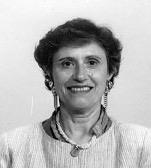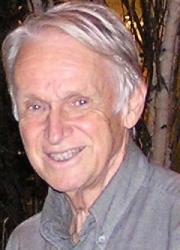Related Research Articles

Murray Gell-Mann was an American physicist who received the 1969 Nobel Prize in Physics for his work on the theory of elementary particles. He was the Robert Andrews Millikan Professor of Theoretical Physics Emeritus at the California Institute of Technology, a distinguished fellow and one of the co-founders of the Santa Fe Institute, a professor of physics at the University of New Mexico, and the Presidential Professor of Physics and Medicine at the University of Southern California.

Jack Steinberger was a German-born American physicist noted for his work with neutrinos, the subatomic particles considered to be elementary constituents of matter. He was a recipient of the 1988 Nobel Prize in Physics, along with Leon M. Lederman and Melvin Schwartz, for the discovery of the muon neutrino. Through his career as an experimental particle physicist, he held positions at the University of California, Berkeley, Columbia University (1950–68), and the CERN (1968–86). He was also a recipient of the United States National Medal of Science in 1988, and the Matteucci Medal from the Italian Academy of Sciences in 1990.

In physics, the eightfold way is an organizational scheme for a class of subatomic particles known as hadrons that led to the development of the quark model. American physicist Murray Gell-Mann and Israeli physicist Yuval Ne'eman both proposed the idea in 1961. The name comes from Gell-Mann's (1961) paper and is an allusion to the Noble Eightfold Path of Buddhism.

The nuclear force is a force that acts between the protons and neutrons of atoms. Neutrons and protons, both nucleons, are affected by the nuclear force almost identically. Since protons have charge +1 e, they experience an electric force that tends to push them apart, but at short range the attractive nuclear force is strong enough to overcome the electromagnetic force. The nuclear force binds nucleons into atomic nuclei.
The MIT Center for Theoretical Physics (CTP) is the hub of theoretical nuclear physics, particle physics, and quantum information research at MIT. It is a subdivision of MIT Laboratory for Nuclear Science and Department of Physics.
Richard Samuel Ward FRS is a British mathematical physicist. He is a Professor of Mathematical & Theoretical Particle Physics at the University of Durham.

Alexey Andreevich Anselm was a Russian theoretical physicist, Doctor of Physical and Mathematical Sciences, professor, director (1992–1994) of the B.P. Konstantinov Petersburg Nuclear Physics Institute (PNPI), member of: the Russian and American Physical Society, the executive committee of the Nuclear Physics Branch of the Russian Academy of Sciences, the editorial board of the Russian journal “Yadernaya Fizika”.
The National Society of Black Physicists (NSBP), established in the United States in 1977, is a non-profit professional organization with the goal to promote the professional well-being of African Diaspora physicists and physics students within the international scientific community and the world community at large.
The rms charge radius is a measure of the size of an atomic nucleus, particularly the proton distribution. The proton radius is approximately one femtometre = 10−15 metres. It can be measured by the scattering of electrons by the nucleus. Relative changes in the mean squared nuclear charge distribution can be precisely measured with atomic spectroscopy.
John Bryan Taylor is a British physicist known for his contributions to plasma physics and their application in the field of fusion energy. Notable among these is the development of the "Taylor state", describing a minimum-energy configuration that conserves magnetic helicity. Another development was his work on the ballooning transformation, which describes the motion of plasma in toroidal (donut) configurations, which are used in the fusion field. Taylor has also made contributions to the theory of the Earth's Dynamo, including the Taylor constraint.

Richard Edward Taylor,, was a Canadian physicist and Stanford University professor. He shared the 1990 Nobel Prize in Physics with Jerome Friedman and Henry Kendall "for their pioneering investigations concerning deep inelastic scattering of electrons on protons and bound neutrons, which have been of essential importance for the development of the quark model in particle physics."

The Research Institute for Nuclear Problems of Belarusian State University is a research institute in Minsk, Belarus. Its main fields of research are nuclear physics, particle physics, materials science and nanotechnology.

Magda Galula Ericson (born 1929) is a French-Algerian physicist of Tunisian origin. Her experimental pioneering PhD work changed the understanding of critical phenomena near the Curie point and later in her career she has become known for her theoretical development of the Ericson-Ericson Lorentz-Lorenz correction.

Ronald Elbert Mickens is an American physicist and mathematician who is the Fuller E. Callaway Professor of Physics at Clark Atlanta University. His research focuses on nonlinear dynamics and mathematical modeling, including modeling epidemiology. He also has an interest in the history of science and has written on the history of black scientists. He is a fellow of the American Physical Society and served as the historian of the National Society of Black Physicists. He has made significant contributions to the theory of nonlinear oscillations and numerical analysis.
Nathaniel Joseph Fisch is an American plasma physicist known for pioneering the excitation of electric currents in plasmas using electromagnetic waves, which was then used in tokamak experiments. This contributed to an increased understanding of plasma wave–particle interactions in the field for which he was awarded the James Clerk Maxwell Prize for Plasma Physics in 2005 and the Hannes Alfvén Prize in 2015.

Sudhir Ranjan Jain is an Indian theoretical physicist at the Bhabha Atomic Research Centre, Mumbai, known for his contributions in complex quantum systems and Nonlinear dynamics. He is a scientist at the nuclear physics division of Bhabha Atomic Research Centre, professor at Homi Bhabha National Institute and adjunct professor at the Centre for Excellence in Basic Sciences. He authored Mechanics, Waves and Thermodynamics: An Example-based Approach. His doctoral advisor was Prof. Suresh V. Lawande, who was a student of Edward Teller.
Edith Conrad Halbert is an American physicist, elected a Fellow of the American Physical Society in 1972. She worked on computations in the nuclear shell model at the Oak Ridge National Laboratory.

Torleif Erik Oskar Ericson, born November 2, 1930 in Lund, is a Swedish nuclear theoretical physicist. He is known for 'Ericson fluctuations' and the 'Ericson-Ericson Lorentz-Lorenz effect'. His research has nurtured the link between nuclear and particle physics.
George Raymond "Ray" Satchler was a British-American nuclear physicist.
Harry Lee Morrison was an American theoretical physicist and the first African American physics faculty member at the University of California, Berkeley. His research focused on statistical mechanics within theoretical physics, and he was known for his demonstration in 1972 of the absence of long-range order in quantum systems in two dimensions, that was a result from the breaking of a continuous symmetry.
References
- 1 2 3 "James Young". www.nsbp.org. Retrieved September 18, 2019.
- ↑ Young, J. E.; Mawardi, O. K. (September 1, 1954). "On the Propagation of Noise in Pipes. II". The Journal of the Acoustical Society of America. 26 (5): 938. Bibcode:1954ASAJ...26..938Y. doi: 10.1121/1.1927969 . ISSN 0001-4966.
- 1 2 History, Mit Black (October 24, 2015). "Capture the MO*MIT: MIT Physicist - James Edward Young". Capture the MO*MIT. Retrieved September 18, 2019.
- ↑ Das, T.; Guralnik, G. S.; Mathur, V. S.; Low, F. E.; Young, J. E. (May 1, 1967). "Electromagnetic Mass Difference of Pions". Physical Review Letters. 18 (18): 759–761. Bibcode:1967PhRvL..18..759D. doi:10.1103/PhysRevLett.18.759.
- ↑ Young, James E. (February 1, 1961). "The optical model and deuteron stripping". Nuclear Physics. 23: 40–52. Bibcode:1961NucPh..23...40Y. doi:10.1016/0029-5582(61)90237-1. ISSN 0029-5582.
- ↑ Chang, T. S.; Nicoll, J. F.; Young, J. E. (August 21, 1978). "A closed-form differential renormalization-group generator for critical dynamics". Physics Letters A. 67 (4): 287–290. Bibcode:1978PhLA...67..287C. doi:10.1016/0375-9601(78)90306-7. ISSN 0375-9601.
- ↑ "James E. Young, 1983". MIT Black History. Retrieved December 30, 2019.
- ↑ "James E. Young, 1983". MIT Black History. Retrieved September 18, 2019.
- 1 2 Kennedy, Hugh P.; Schrils, Rudolph (January 13, 2015). Intermediate Structure in Nuclear Reactions. University Press of Kentucky. ISBN 9780813163314.
- ↑ Jones, C. EDWARD; Low, F. E.; Young, J. E. (January 1, 1972), Morse, PHILIP M.; Feld, BERNARD T.; Feshbach, HERMAN; Wilson, RICHARD (eds.), "Generalized O(2,1) Expansion for Asymptotically Growing Amplitudes**This work is supported in part by the U. S. Atomic Energy Commission under Contract AT(30-1)-2098.", Nuclear, Particle and Many Body Physics, Academic Press, pp. 476–496, ISBN 9780125082013 , retrieved September 18, 2019
- ↑ "Shirley Jackson". www.nsbp.org. Retrieved September 18, 2019.
- ↑ Jordan, Diann (2006). Sisters in Science: Conversations with Black Women Scientists about Race, Gender, and Their Passion for Science. Purdue University Press. ISBN 9781557534453.
{{cite book}}: CS1 maint: url-status (link) - ↑ "MIT Department of Physics". web.mit.edu. Retrieved September 18, 2019.
- 1 2 E, Mickens Ronald (February 4, 2002). Edward Bouchet: The First African-american Doctorate. World Scientific. ISBN 9789814488884.